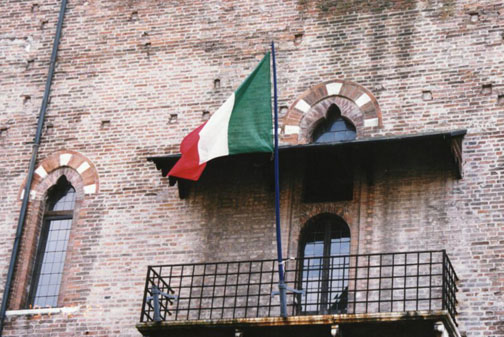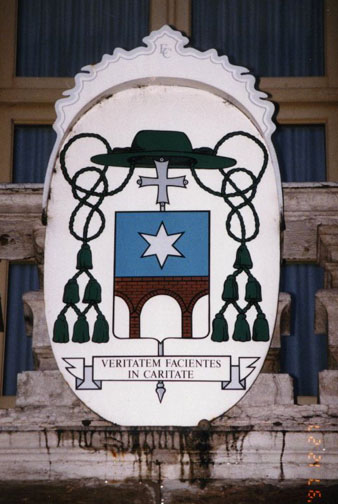

Mantova

a city in Italy

Mantua (Italian Mantova), city, northern Italy, capital of Mantua Province, in Lombardy (Lombardia) Region, surrounded on three sides by the Mincio River. A tourist and agricultural center, Mantua has factories producing agricultural machinery, fertilizer, furniture, shoes, and toys. Among the notable buildings is the Doge's Palace (Palazzo Ducale), with frescoes by Andrea Mantegna, whose tomb is in Sant'Andrea, a basilica begun in the 15th century.
Central Piazza
the other side
Mantegna, Andrea (1431-1506), one of the foremost north Italian painters of the 15th century. A master of perspective and foreshortening, he made important contributions to the compositional techniques of Renaissance painting. He may also have been a printmaker.
Mantegna was probably born at Isola di Carturo, between Vicenza and Padua (Padova), and became the apprentice and adopted son of the painter Francesco Squarcione of Padua. He developed a passionate interest in classical antiquity. The influence of both ancient Roman sculpture and the contemporary sculptor Donatello are clearly evident in Mantegna's rendering of the human figure. His human forms were distinguished for their solidity, expressiveness, and anatomical correctness.
shop front at Christmas
Mantegna's principal works in Padua were religious. His first great success was a series of frescoes on the lives of Saint James and Saint Christopher in the Ovetari Chapel of the Church of the Eremitani (1448?-1457?; badly damaged in World War II, 1939-1945). In 1459 Mantegna went to Mantua (Mantova) to become court painter to the ruling Gonzaga family and accordingly turned from religious to secular and allegorical subjects. His masterpiece was a series of frescoes (1465-1474) for the Camera degli Sposi ("bridal chamber") of the Doge's Palace (Palazzo Ducale). In these works, he carried the art of illusionistic perspective to new levels. His figures depicting the court were not simply applied to the wall like flat portraits but appeared to be taking part in realistic scenes, as if the walls had disappeared. The illusion is carried over onto the ceiling, which appears to have an oculus (circular opening) open to the sky, with servants, a peacock, and cherubs leaning over a railing. This was the prototype of illusionistic ceiling painting and was to become an important element of baroque and rococo art.
the theater
teatro di Sabbioneta (1588-1590).Mantegna's later works reveal varied talents. His largest undertaking, a series of nine canvases depicting the Triumphs of Caesar (1490s?, Hampton Court Palace, England), displays his keen interest in academic classicism. Parnassus (1497, Louvre, Paris), an allegorical painting commissioned by Isabelle d'Este, is his freshest, most animated work. His work never ceased to be innovative. In The Madonna of Victory (1495, Louvre), he introduced a new compositional arrangement, based on diagonals, which was later to be exploited by Correggio, while his Dead Christ (1506, Pinacoteca di Brera, Milan) was a tour de force of foreshortening that pointed ahead to the style of 16th-century Mannerism.
One of the key artistic figures of the second half of the 15th century, Mantegna was the dominant influence on north Italian painting for 50 years. He particularly influenced his brother-in-law, Venetian painter Giovanni Bellini. It was also through Mantegna that German artists, notably Albrecht Dürer, were made aware of the artistic discoveries of the Italian Renaissance.
a market square
the tower
Mannerism, in art, a style that developed in Italy in the 16th century and evolved between the High Renaissance and the baroque. Mannerist painting is characterized by the use of attenuated figures in exaggerated postures (plastically rendered, nevertheless); the unrealistic treatment of space, often for dramatic effect; and often a seemingly arbitrary choice of thin, discordant, often acid colors.
One of the first applications of Mannerism to the decorative arts and to architecture is seen in the work of Giulio Romano at the Palazzo del Tè, Mantua (Mantova), Italy (begun 1525?).
classic style
An Etruscan, and later a Roman, town, Mantua was captured by the Lombards in the 6th century. The town became a possession of the margrave of Canossa until it achieved independence in 1115. The city prospered under the rule (1328-1708) of the Gonzaga family. Mantua was held by Austria, except for a brief period, from 1708 to 1866. Population (1990 estimate) 54,800.
Text from Microsoft Encarta
Mantova architectural styles
detail
![]()
![]()